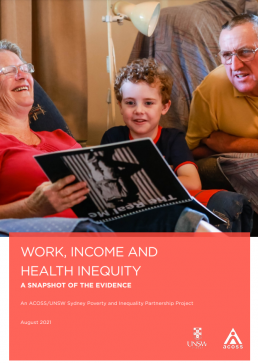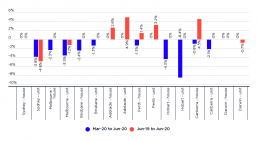Heart, stroke and vascular diseases, diabetes and arthritis by SEIFA
Those within lower socio economic indexes for areas reported higher levels of Heart, stroke and vascular diseases, diabetes and arthritis than those in higher socio economic indexes for areas (SEIFA).
To find out more about SEIFA, go to https://www.abs.gov.au/websitedbs/censushome.nsf/home/seifa
Heart, stroke and vascular diseases, diabetes and arthritis and diabetes by labour force status group
Those not in the labour force, aged either above or below 65, report higher levels of heart, stroke and vascular diseases, diabetes and arthritis than those working part or full time.
Heart, stroke and vascular diseases, diabetes and arthritis by income group
Those in lower income groups report higher levels of heart, stroke and vascular diseases, diabetes and arthritis than those in higher income groups.
Good self-assessed health by weekly equivalised household income
This graphs shows that those in the higher income groups report higher levels of good health than those in the lower income groups.
Poverty and inequality primary and secondary education resources
Education resources, in partnership with Anti-Poverty Week Australia, prepared by Cool Australia.
View them at: https://cool.org/poverty-and-inequality-education-resources
Report lays bare Australia’s stark health income gap as COVID widens it further
As major inequities in the vaccine roll out emerge, ACOSS and UNSW Sydney have today released a report showing the relationship between income and health.
Australian Council of Social Service CEO Dr Cassandra Goldie said: “The pandemic has exposed the stark inequities that impact our health across the country. People on the lowest incomes, and with insecure work and housing have been at greatest risk throughout the COVID crisis. Now, they are the same people who are at risk of missing out in the vaccine roll out.
“Our report shows that health inequities are built into our society. Our report shows that people on low incomes have the highest levels of psychological distress, and we know that the pandemic is increasing that distress.
“People on lower incomes are also at greater risk of chronic illnesses, which can also make them more at risk to the impacts of the pandemic.”
Professor Evelyne de Leeuw, Director of Centre for Health Equity Training, Research & Evaluation, said: "It's clear that income and wealth help determine health outcome in Australia,with our report showing those in the highest income group are more than twice as likely to be in good health than those in the lowest income group.
"Without urgent government action, the pandemic is only set to widen this inequality, with people on lower incomes already being left behind in the vaccine rollout. Many live in insecure, over-crowded housing or work in roles that annot be carried out from home. Health inequities are not a given; they are a consequence of how our societies work."
Australian Council of Social Service CEO Dr Cassandra Goldie continued:
“Improving health for all is not only about investing in our health system – it’s also about income support, housing and community services. We must deliver on the basic economic supports and social determinants of health such as adequate and secure incomes and housing, including in lockdowns, so that we can improve health for all and get through the COVID crisis.
“As the wealthiest country in the world, it is inexcusable that we have not tackled preventable health inequalities. Far too many people have poorer health outcomes by reason of preventable economic and social disadvantage.”
The report finds that:
- People in the highest income group are twice as likely (60%) to report their health status as good, very good or excellent, compared with only 33% of those in the lowest income group.
- People on social security payments under 65 were considerably more likely to have asthma (19%) than those whose main income was wages or salary (11%).
- Half of people on social security payments under 65 report mental health conditions (50%). This is over twice as many as those whose main source of income is wages or salary (18%).
- Over a third of people on social security payments under 65 report high psychological distress (36%), compared with 10% of people whose main source of income is wages or salary.
Read the report at: http://povertyandinequality.acoss.org.au/publication/work-income-and-health-inequity
Work, income and health inequity
Work, income and health inequity: A snapshot of the evidence
Download the report at https://bit.ly/3jIaqTX
Quarterly asking median rent per week, houses
This graph shows that in every state capital except Hoabrt, the median asking rent for houses increased during the September quarter 2020 to at least the same level as before the pandemic; and in several cities increased to a greater level.
Change in median asking rents, quarter on quarter and year on year to June 2020
This graph compares hte decline in median advertised rents from both the first quarter of 2020 and the June quarter of 2019 for both houses and units in each of the state capitals, showing the immediate impact of the pandemic on unit rents in Sydney, Melbourne and Hobart. Only in Sydney and Melbourne did asking rents fall to lower than the median price for the same time the previous year. In contrast, the effect on median asking rents for houses was much smaller, barring Hobart. In Adelaide, Perth and Canberra, median asking rents remained higher than they had been during the June quarter of 2019.
Airbnb listings for entire houses, Melbourne, January to October 2020
This graph shows the data for listings from InsideAirbnb for Melbourne during the period January to October 2020. It shows that listings for entire homes contracted by 22% since COVID-19 restrictions were introduced, equating to 3,661 dwellings that were presumably available previously for long term lease or purchase. The decline is most pronounced in the inner rings of Melbourne. It suggests that, while many of these properties might have been sold, re-occupied by owners, or left unoccupied, there was likely a substantial increase in the supply of longer term private rental properties in inner-Melbourne.







